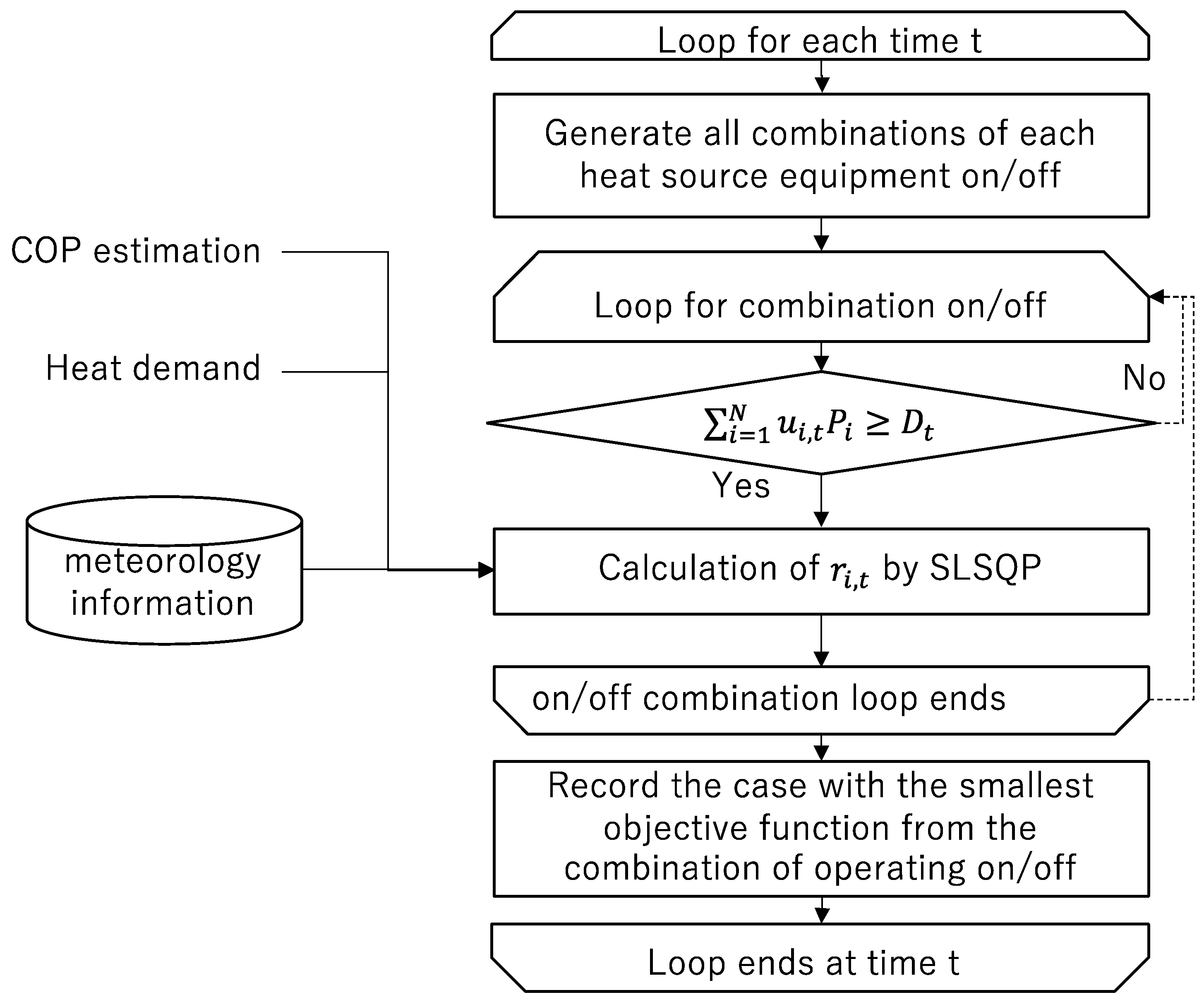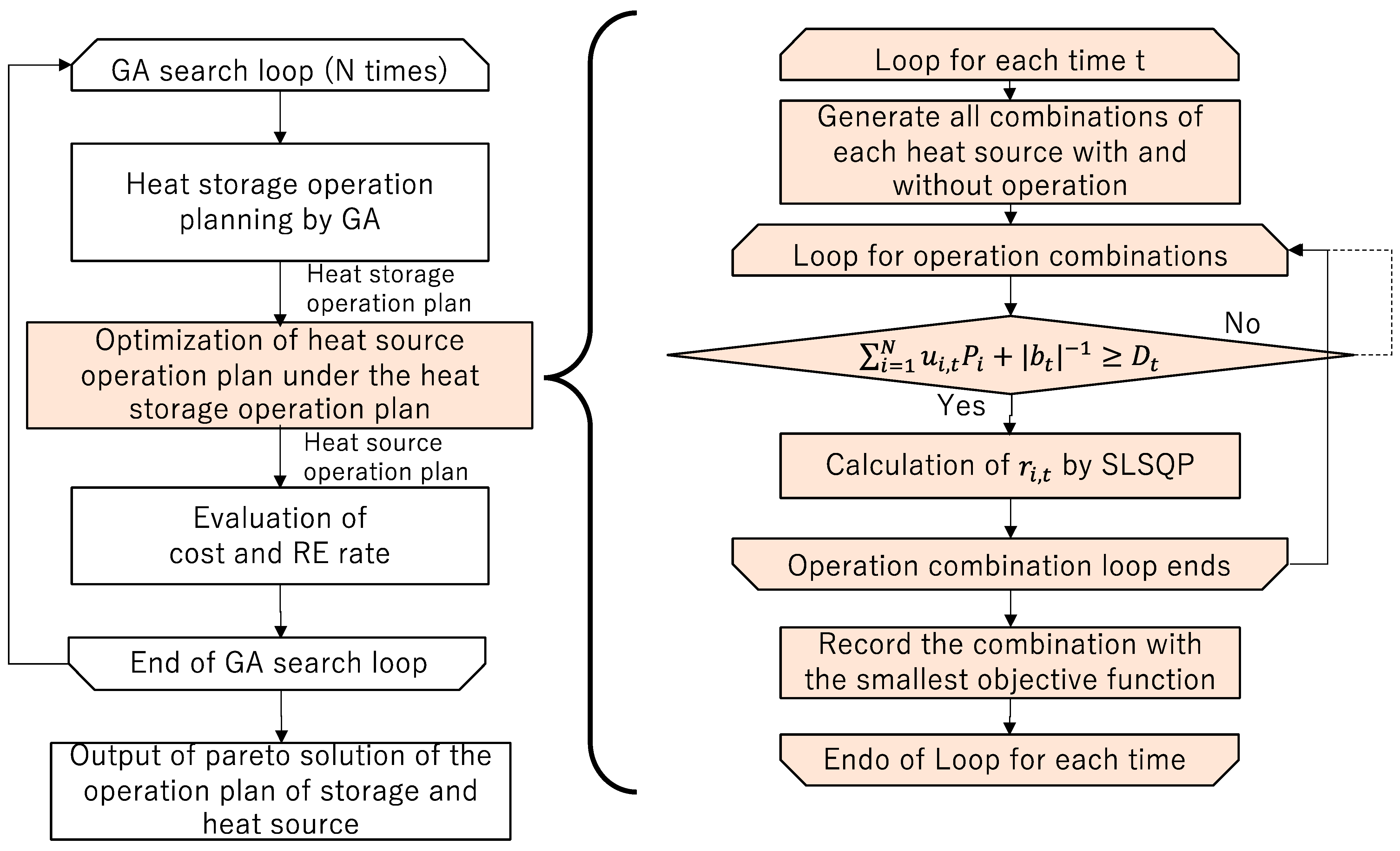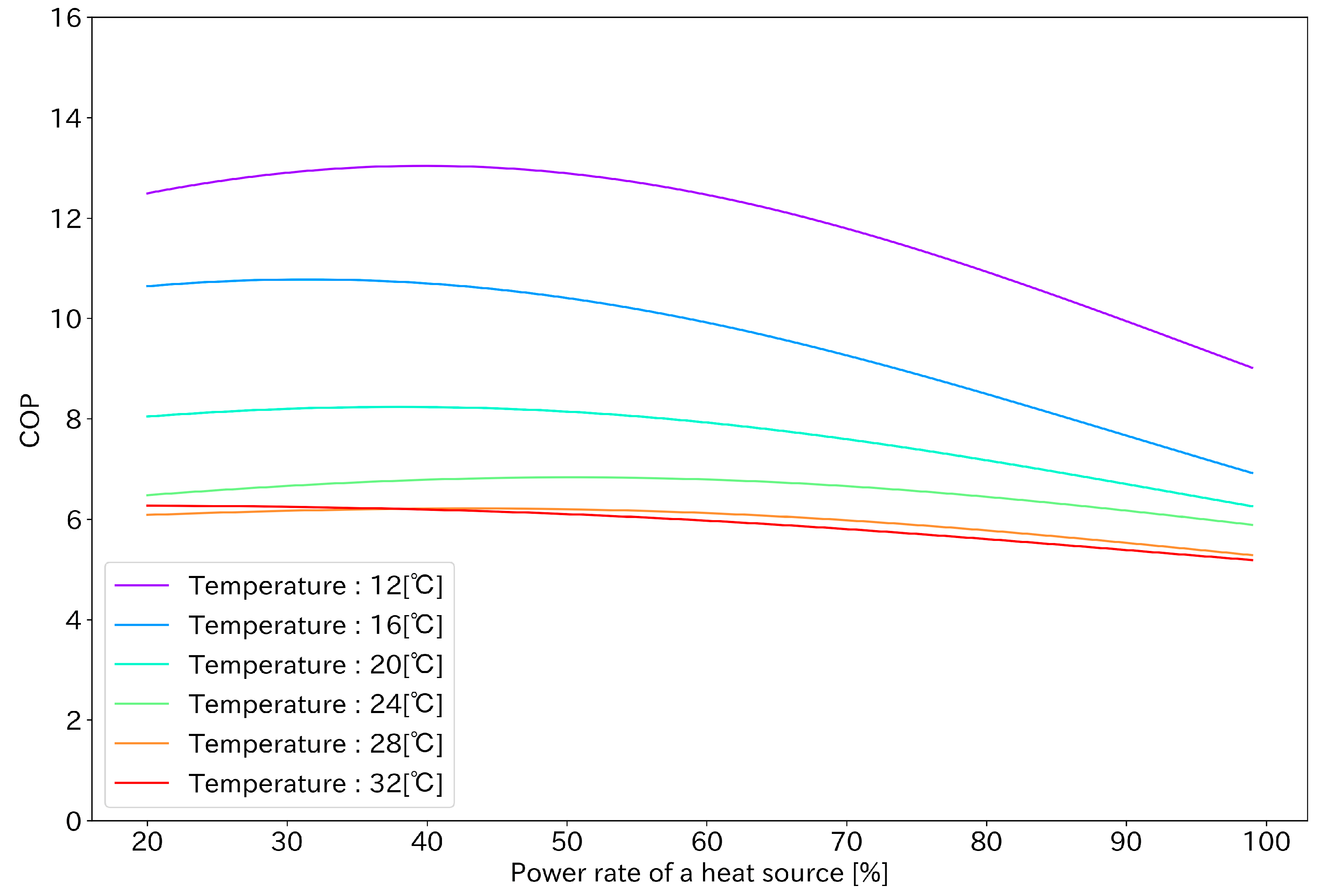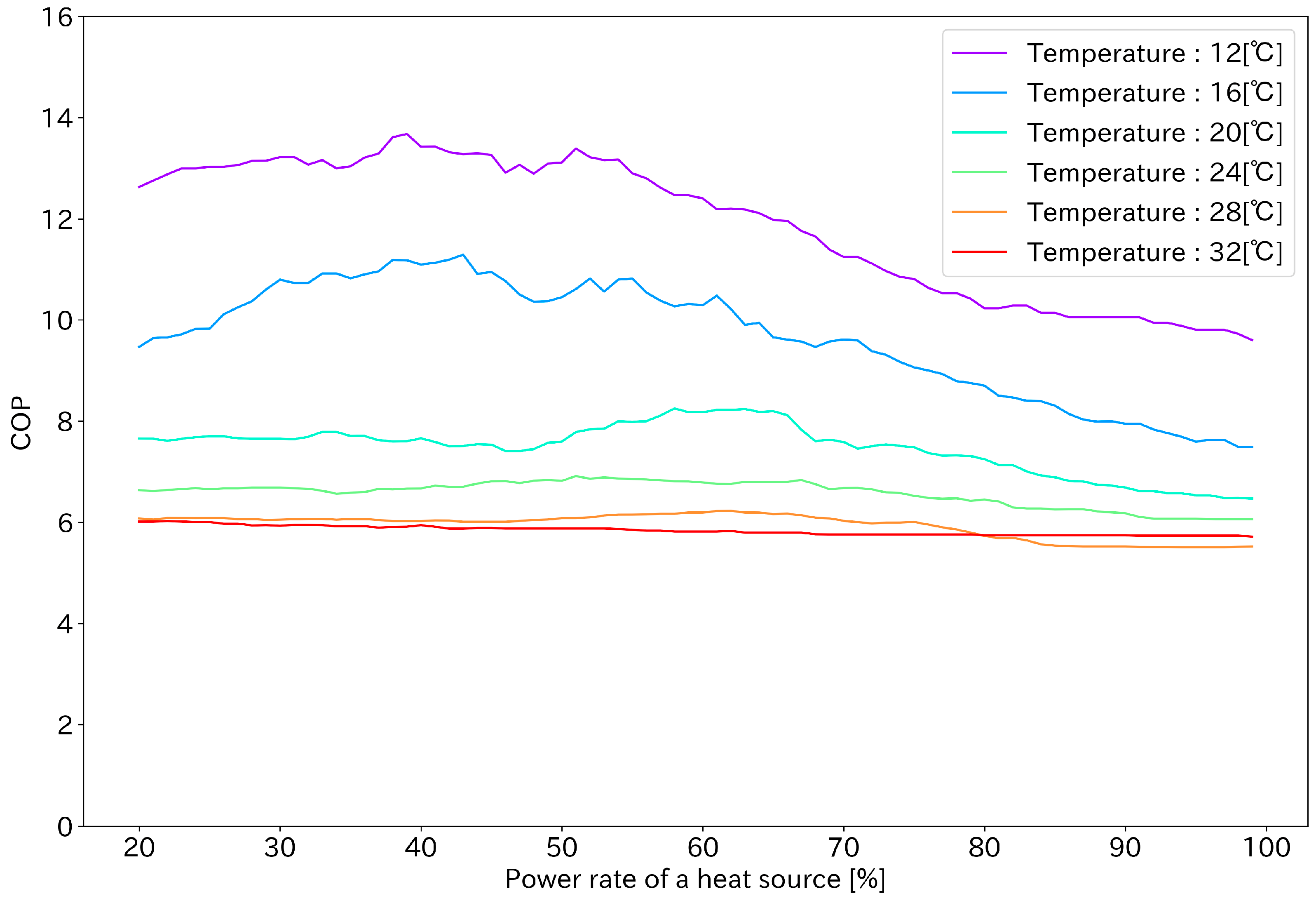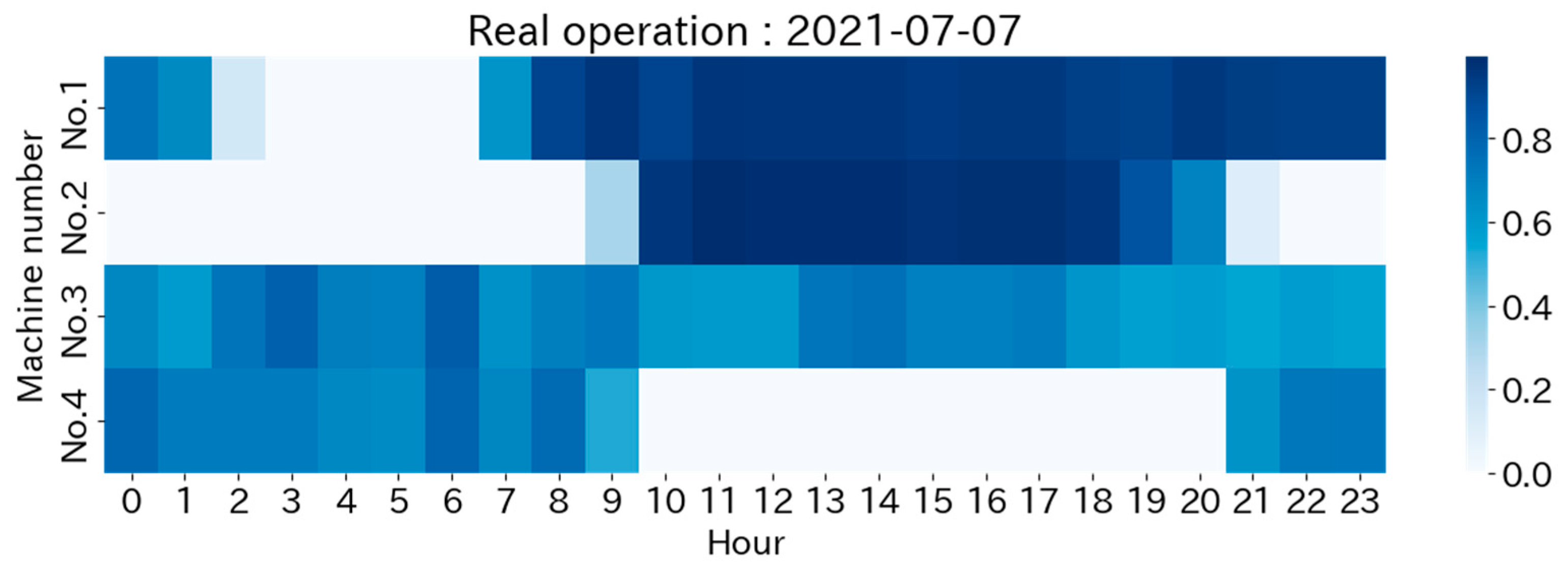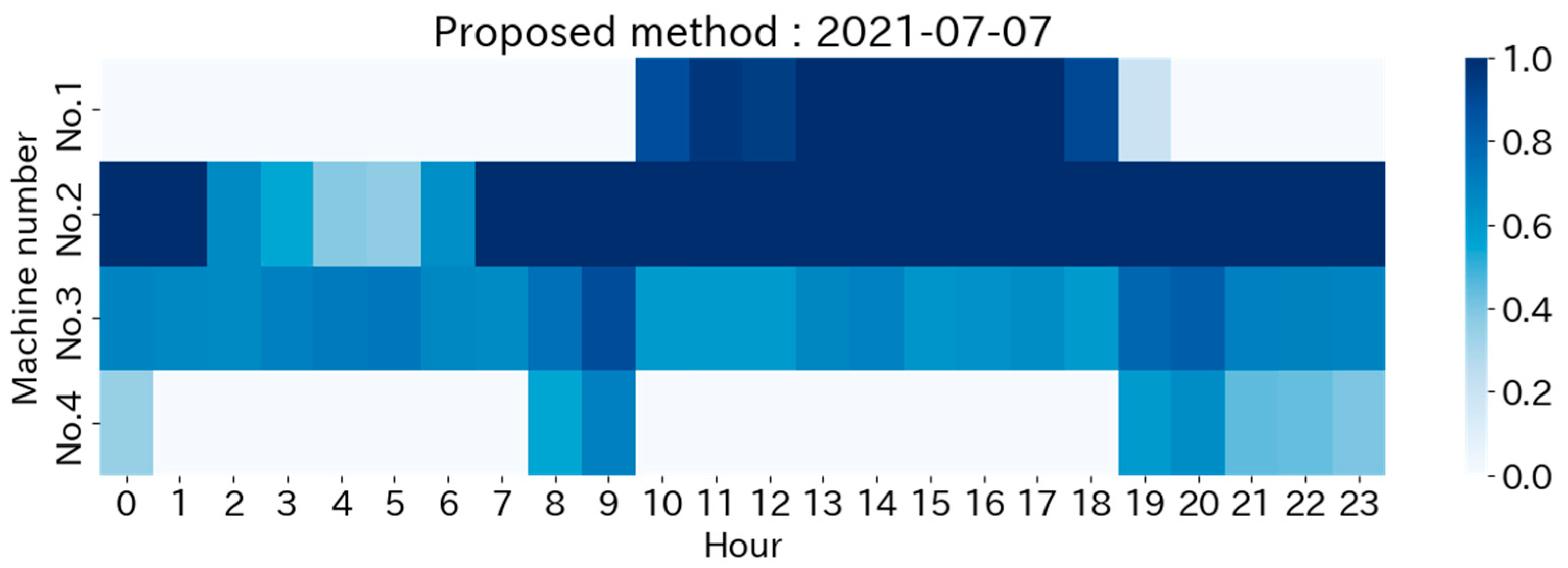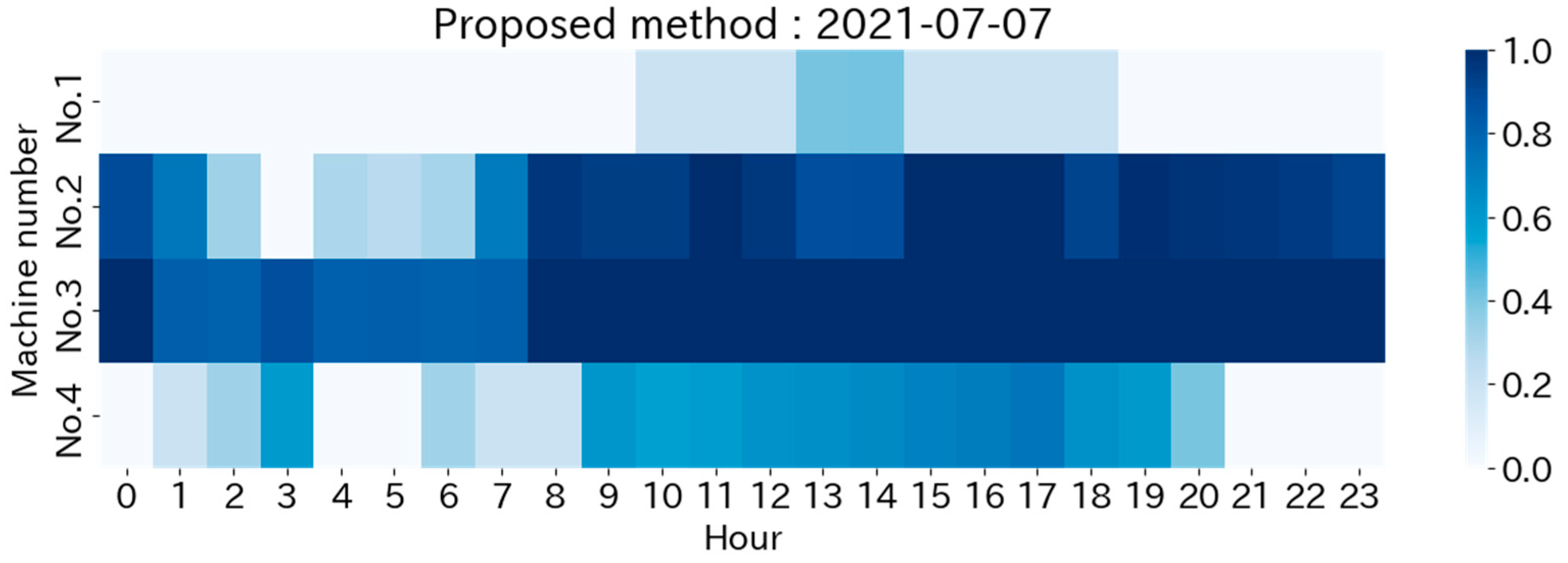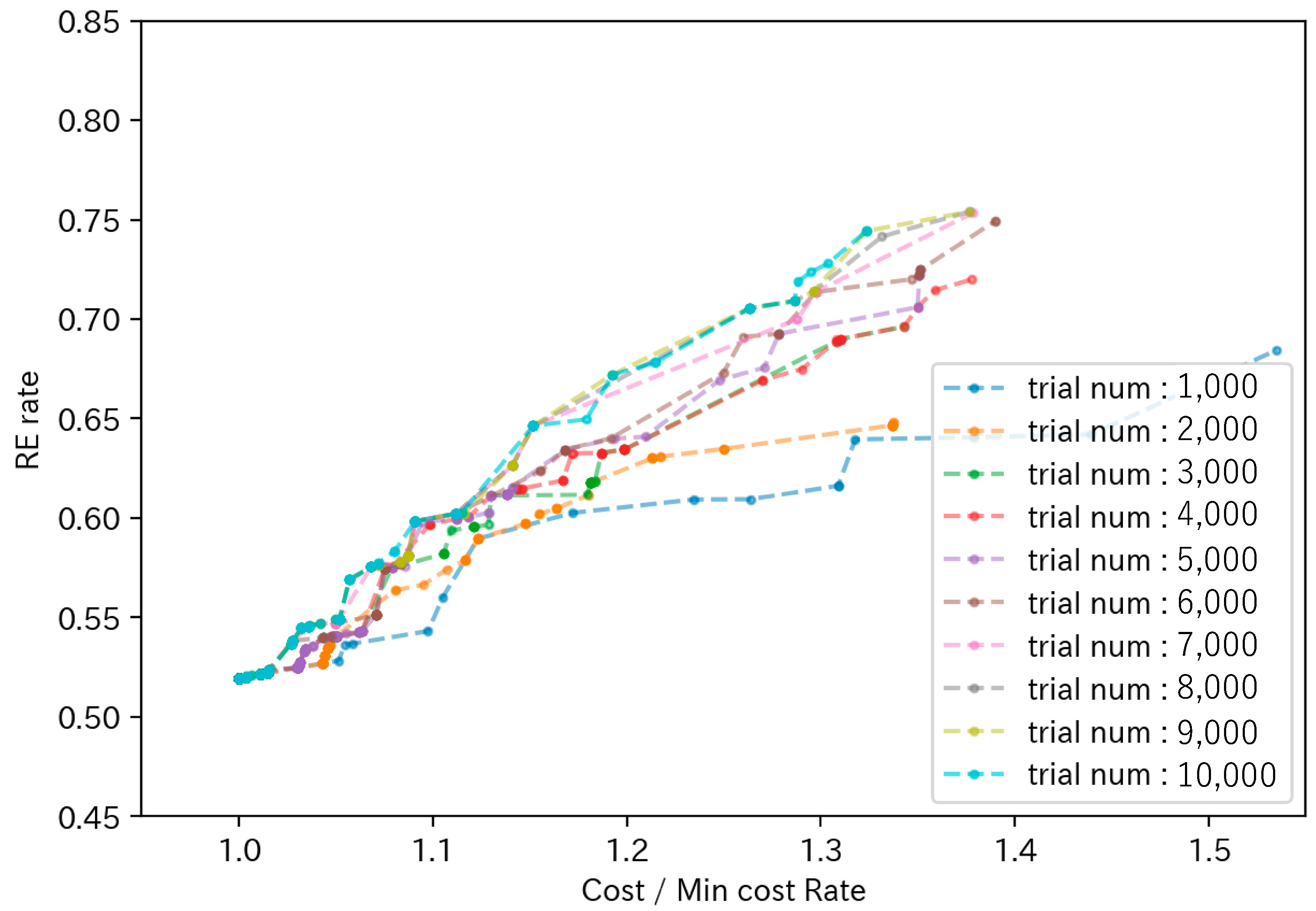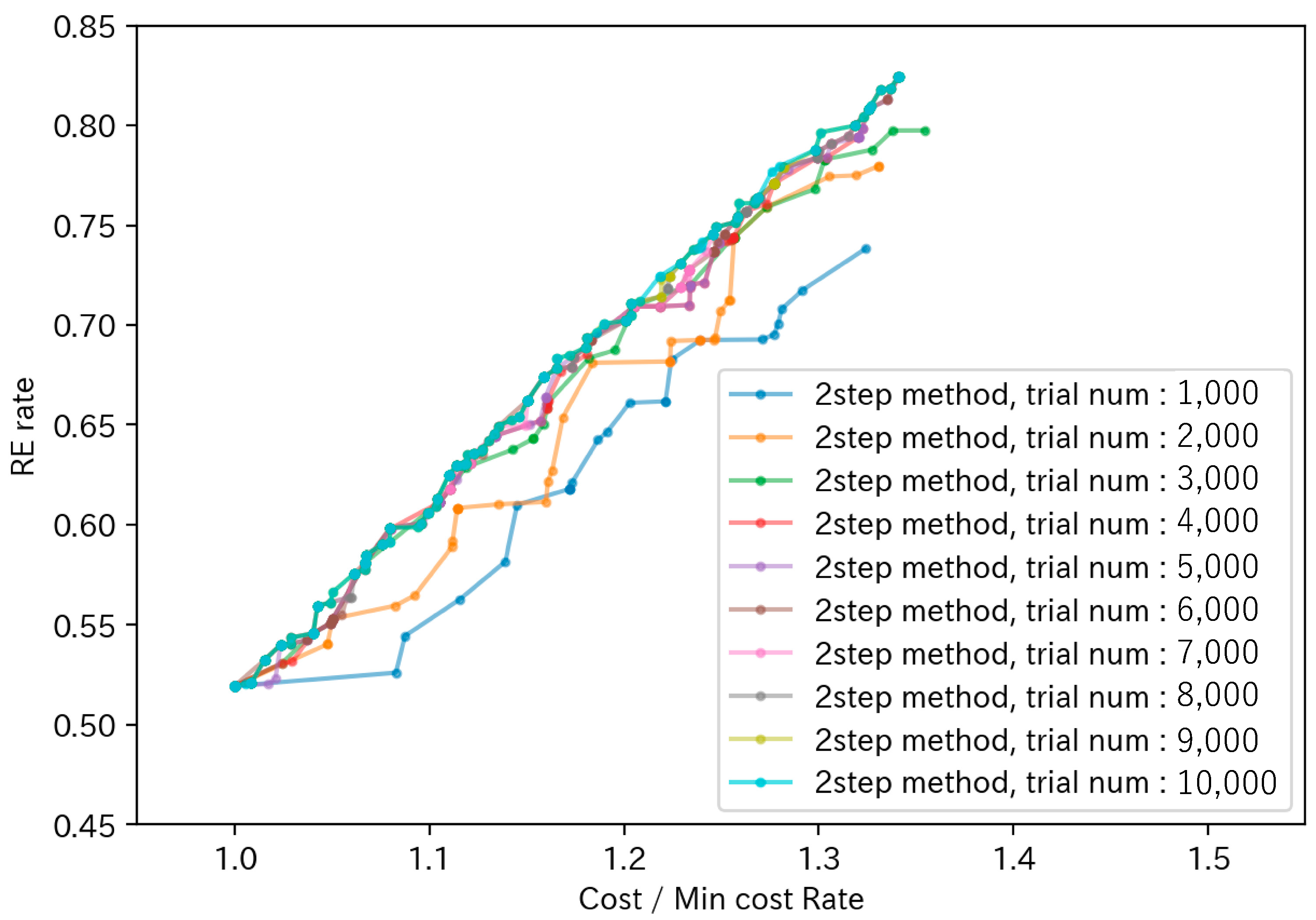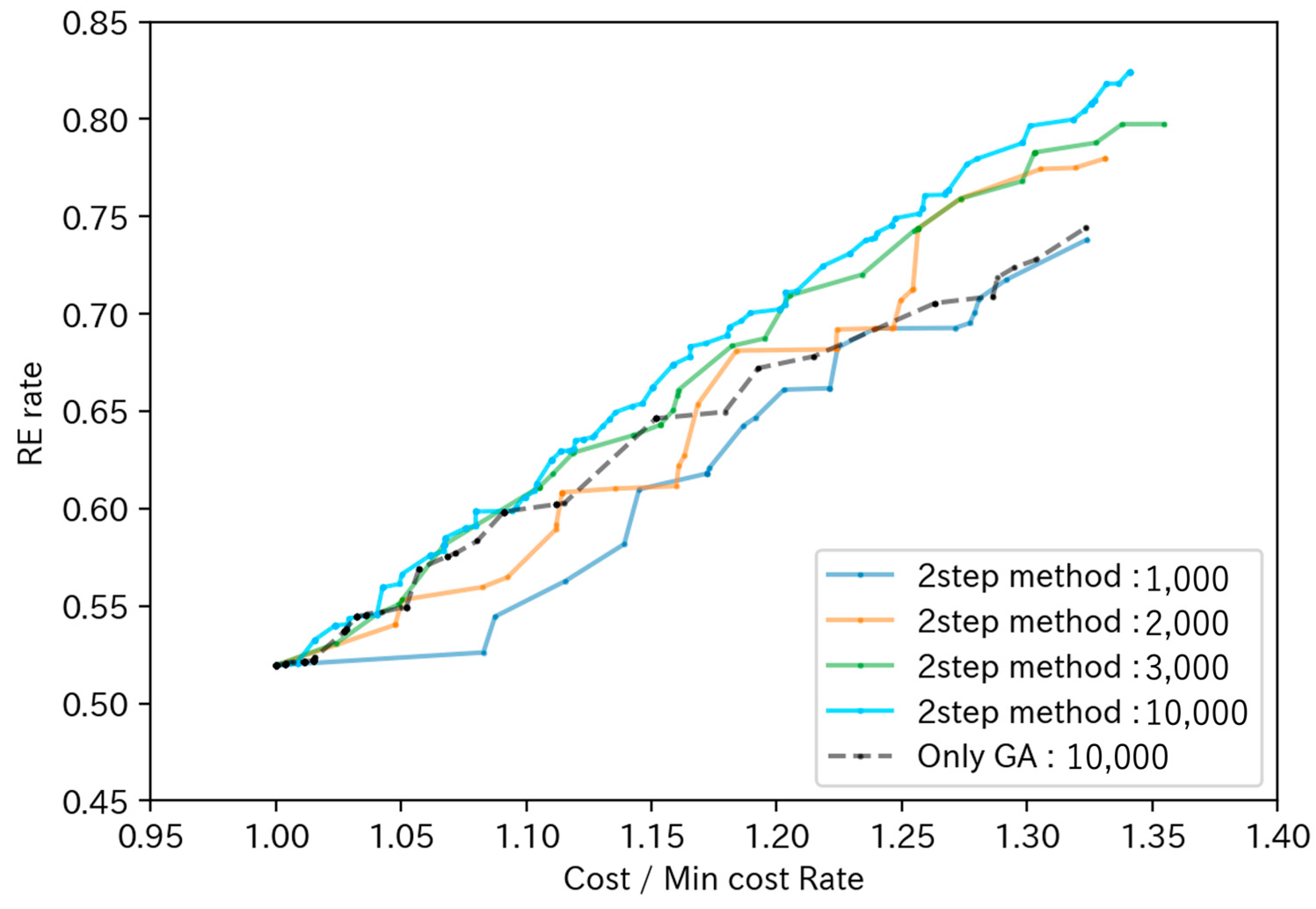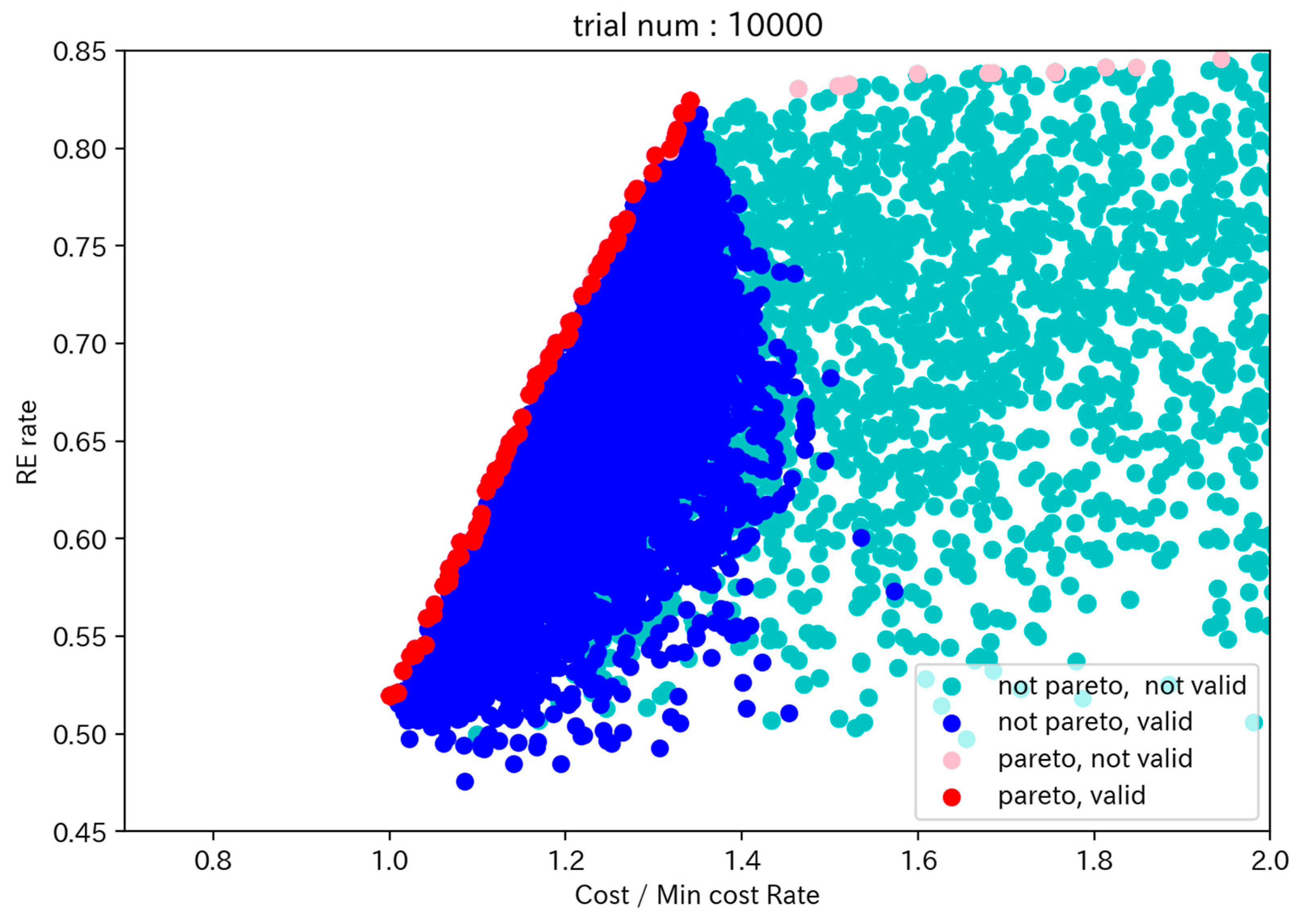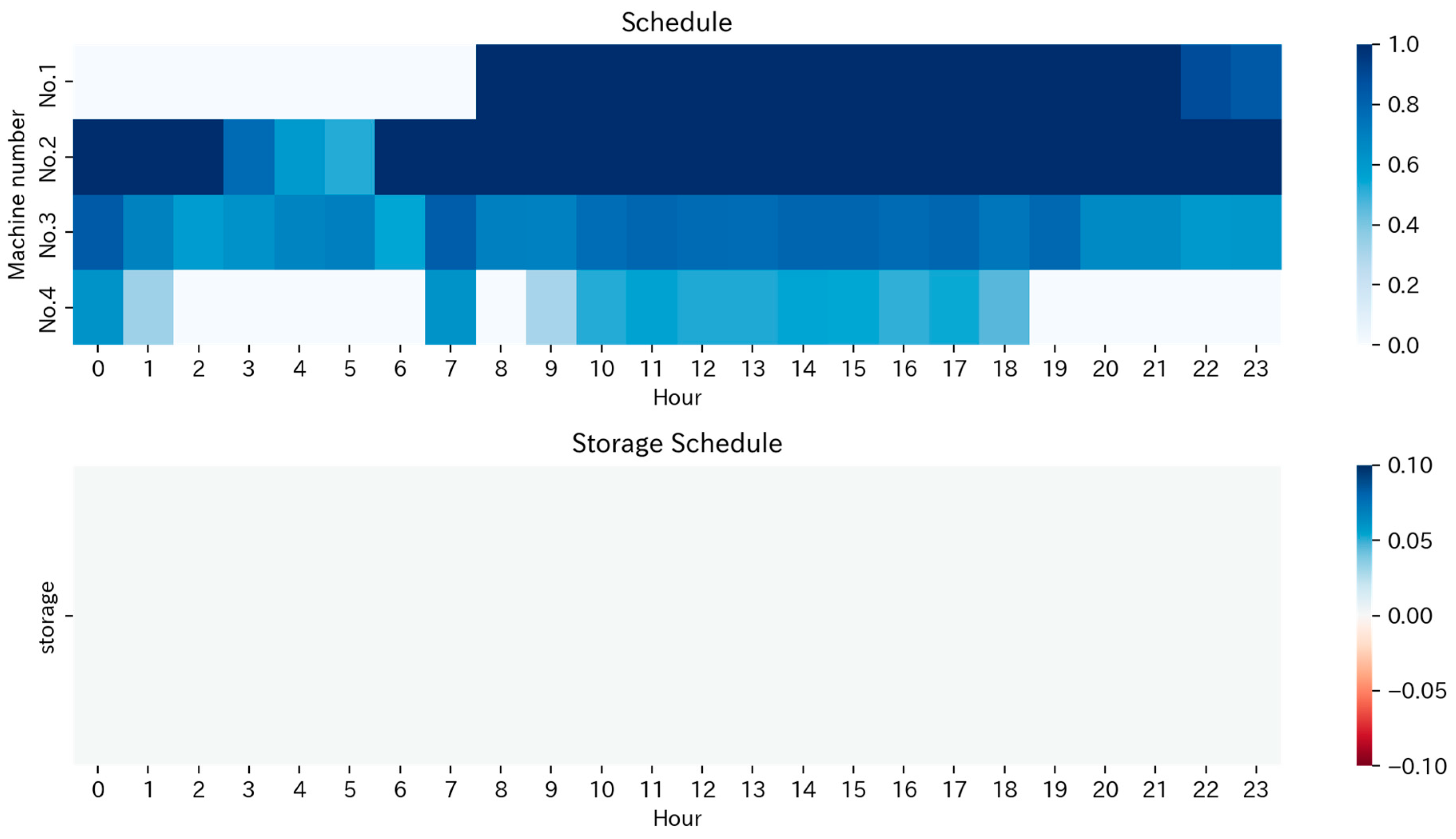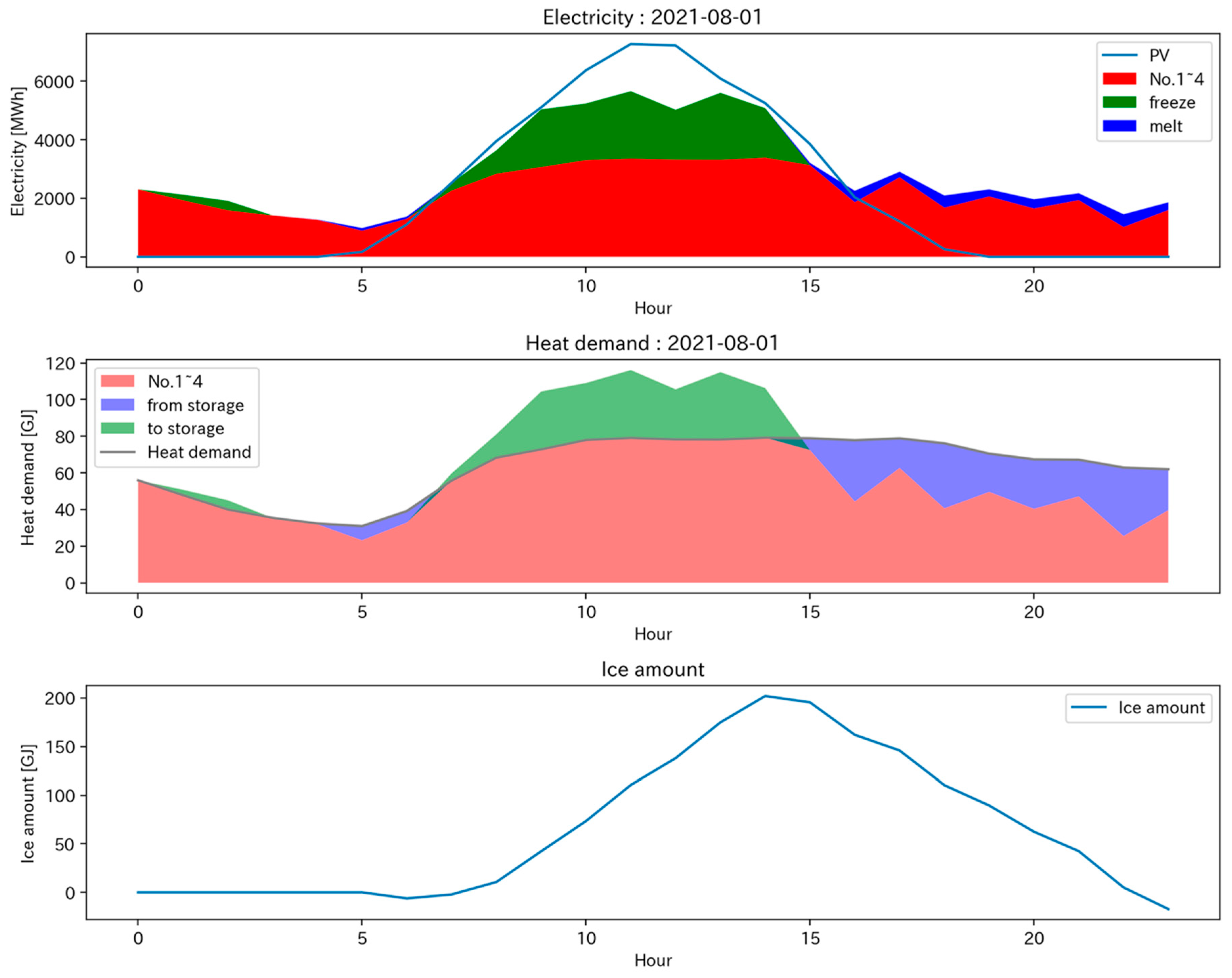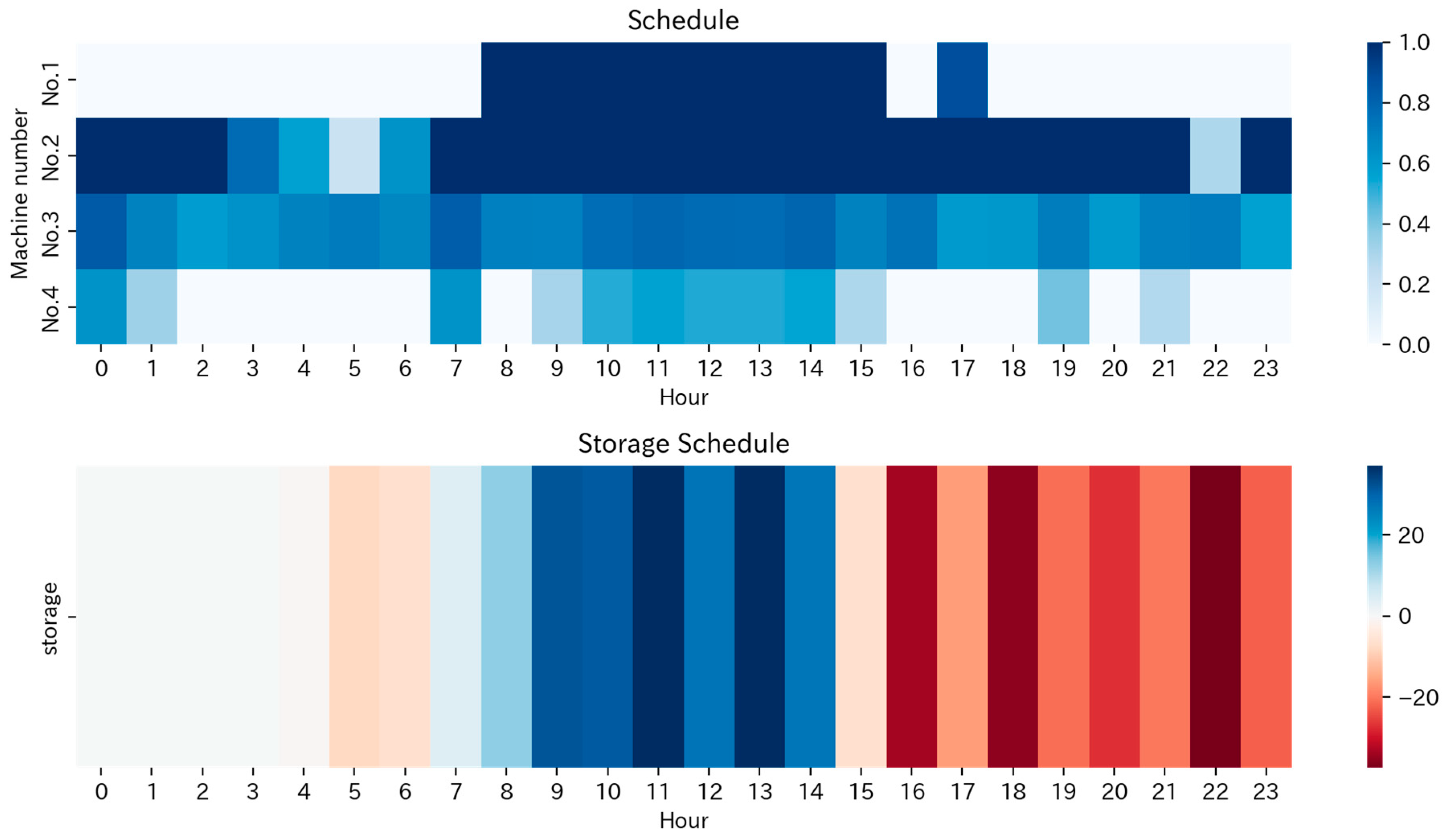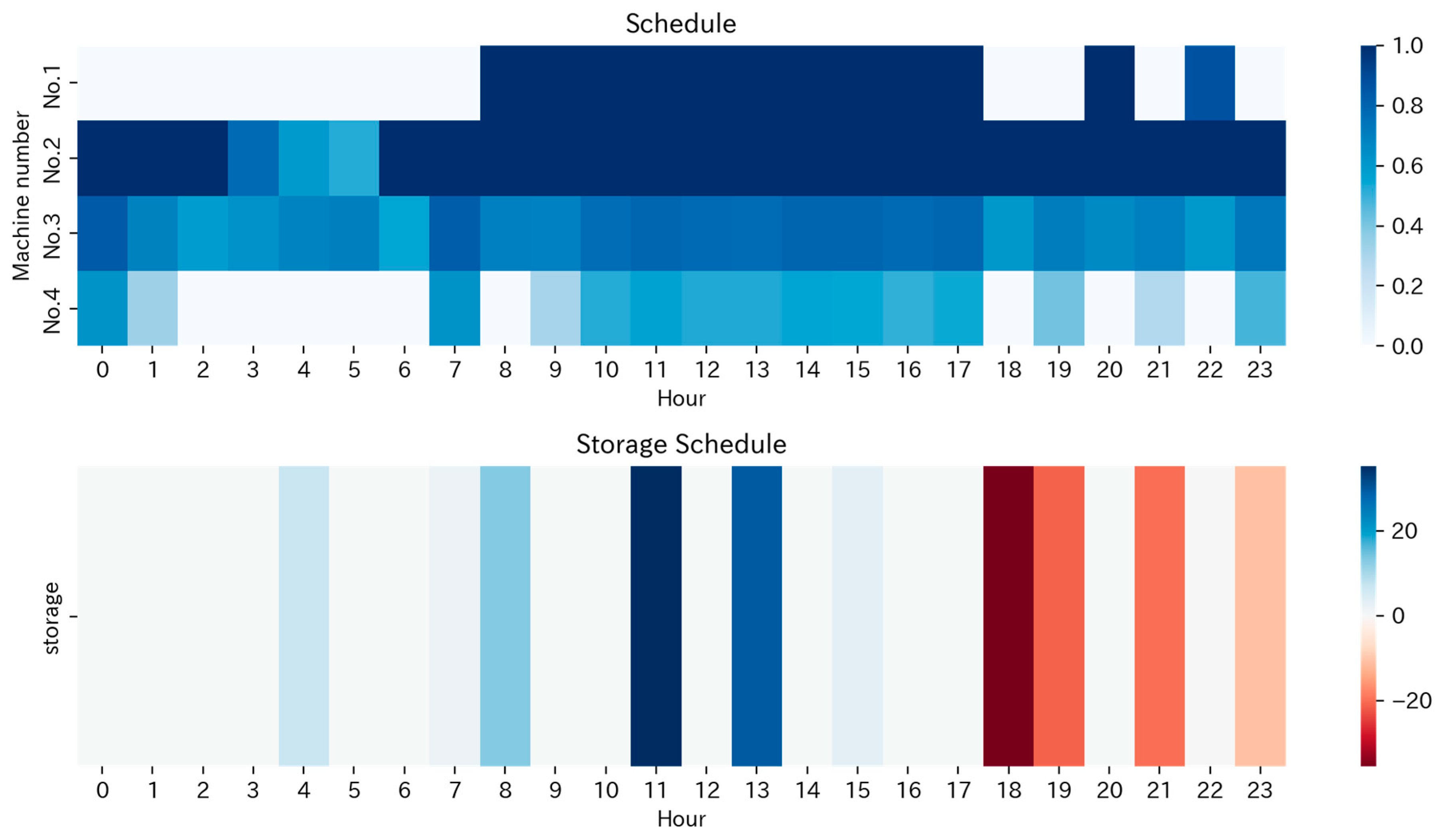3.2. Case Studies of Methods for Estimating COP Based on Actual Operational Data
The COP is estimated for four chillers using one year of operating data. Chillers 1 and 2 are turbo chillers, and chillers 3 and 4 are inverter turbo chillers. The latter is characterized by a maximum COP at a load ratio of 30 to 40% when the temperature is low.
These four chillers were modeled and evaluated with k-partition cross-validation (k = 10), and the results are shown in
Table 3,
Table 4,
Table 5 and
Table 6, respectively. The error indices are MAE: Mean Absolute Error, RMSE: Root Mean Squared Error, and MAPE: Mean Percentage Error. Overall, the accuracy of SVR’s RBF kernel is relatively good. Next is the K-nearest neighbor method.
Figure 4 and
Figure 5 show the results of estimating the COP of chiller 4 using these two methods:
Figure 4 with the SVR:RBF kernel shows a smooth line while
Figure 5 with the K-nearest neighbor shows a line where the COP is not stable with respect to the output ratio. Although this function is used as a part of the objective function, the SVR: RBF kernel is used here because it is preferable to use smoother lines because unstable lines are more likely to lead to local solutions since the gradient information of the objective function is used to solve the optimization problem.
Assuming that increasing the output ratio
increases the energy consumption, we mentioned that
in the objective function is a monotonically increasing function with respect to
, but in reality, based on the estimated COP, when
was plotted, a monotonically increasing line was obtained as shown in
Figure 6. Optimization can be performed for this COP function using a gradient-based optimization method.
3.3. Case Study of a Heat Source Equipment Operation Planning Method Considering COP Variation
The actual operation history is compared with the cost of operation using the planning method, which takes into account the variation of the COP using the proposed method, to verify how much cost reduction can be achieved by the proposed method. The learned COP model estimated previously is used, and
Table 7 shows the results of power consumption reduction by the proposed method in the case of the COP model SVR. The actual power consumption of the actual chiller operation (“Actual” in the table) and the power consumption based on the estimated COP model (“Actual: COP Adjusted” in the table) are set as the comparison targets. “Actual after COP Adjustment” is prepared. “Actual after COP Adjusted” is intended to ensure the equality of the comparison since the energy consumption from the proposed method is calculated based on the estimated COP. For example, if the estimated COP function is inaccurate, and the COP is estimated to be higher than it should be, the power consumption in the “Proposed Method” will be improperly evaluated as small. To solve this problem, the “Actual after adjustment for COP” is calculated by dividing the chiller output by the estimated COP and comparing it with the “Proposed Method”. Although PV power generation forecasts, heat demand forecasts, and energy price forecasts are required to develop an actual operational strategy, here, for the sake of proof of concept, forecast values are assumed to be actual values for simplicity. The results for the actual and COP-adjusted results also show that the proposed method can reduce the electricity consumption by approximately 4% per year. Calculated at 14 yen/kWh, this amounts to about 4.1 million yen per year.
Table 8 shows the results of power consumption reduction by the proposed method in the case of the COP model KNN. As shown in
Table 9, KNN takes about three times longer to calculate the plan than the COP model SVR. This may be due to the fact that the COP estimation function with KNN is multimodal, which causes the gradient-based SLSQP calculation to fall into a local solution. It is also thought that the computation took longer for the same reason.
The specific operational schedules generated are examined here.
Figure 7 presents the operational schedule for a given day while
Figure 8 and
Figure 9 depict the schedules proposed by our methodology with the SVR and KNN COP models, respectively, for the same day. The color scheme in these figures indicates the ratio of operation intensity to maximum output.
Figure 10 and
Figure 11 show the heat demand and temperature variations, respectively, for the same day. As can be inferred from
Figure 7, the actual operation bases itself on chiller No.3, adjusting the operation of other chillers in line with the heat demand changes. However, the proposed operation schedule based on the SVR COP model, as shown in
Figure 8, operates primarily on chillers No.2 and No.3. The main difference appears in the comparatively smaller demand period of late night to early morning. While the actual operations mainly involve chillers No.3 and No.4, with chiller No.1 serving as a supplement, the proposed methodology instead primarily operates chillers No.2 and No.3, with No.4 serving in a supplementary capacity.
Figure 12 presents the COP curves of each chiller at a temperature of 26 degrees. Here, chiller No.3 consistently exhibits the highest COP, followed closely by No.2. Hence, based on the COP estimated from the data, it is rational under these weather conditions to prioritize chiller No.2 over No.4. This reasoning is reflected in the schedule generated by our proposed methodology. Moreover, chiller No.4 is more efficient than No.1 when the output ratio is small, but this is reversed around a 75% output ratio. Thus, under these weather conditions, there is a need to switch between chillers No.1 and No.4 according to the heat demand size. Our proposed method prioritizes chiller No.1 when the daytime heat demand is high and then switches to chiller No.4 in the evening when the heat demand decreases, demonstrating rational decision-making. It is difficult to consider both weather conditions and output ratio simultaneously in operations based on intuition and experience. Therefore, a scheduling methodology, such as our proposed one, which is based on an equipment efficiency model derived from actual data, is effective.
3.4. Case Study of an Operational Planning Method Capable of Exploring Trade-Offs between Environmental and Economic Performance
In this section, we conduct a multi-objective optimization comparison using two methods. The first method, depicted in
Figure 2, uses the GA exclusively to decide on the heat storage and release plan, along with the output plan for each heat source equipment. The second method, represented in
Figure 3 employs a two-stage optimization approach.
Table 10 lists the set values of the constants used in this case study. We assume a scenario where the price of power purchased from the retail business remains consistent at 14 JPY/kWh, regardless of the time of day. As for the rate when selling surplus power generated by the PV system, we have considered the purchase price by a retail business for non-FIT (Feed-In Tariff) power. We assumed that 12 MW of PV was installed.
We examine how the Pareto front changes when altering the number of exploratory steps for two optimization techniques.
Figure 13 depicts the evolution of the Pareto front using a method that solely utilizes the Genetic Algorithm (GA). Multiple heat storage and release plans, along with operation plans for a given day, are plotted with the Renewable Energy (RE) rate on the y-axis and the cost ratio (minimized power consumption cost divided by total cost) on the x-axis. As the number of explorations increases, the Pareto front shifts towards the upper left, indicating an improvement with higher RE rates and lower costs. Until 3000 explorations, the Pareto front significantly improves, and after this point, the improvements gradually continue as the number of explorations increases. Beyond 7000 explorations, however, there seems to be little improvement.
Figure 14 illustrates the evolution of the Pareto front using a two-stage optimization method. Compared to
Figure 13, the Pareto front is positioned more towards the upper left overall, indicating superior exploratory performance. Additionally, until 3000 explorations, the Pareto front significantly improves, then it converges, demonstrating the two-stage optimization method’s efficiency per exploration.
To compare and evaluate the differences between the Pareto solutions calculated by the two methods at the same search count,
Figure 15 illustrates the Pareto solutions for both methods for search counts ranging from 1000 to 10,000. As depicted in the figure, the two-stage optimization method (labeled “2 step method” in the figure) generally positions the Pareto curve to the upper left more so than the method using only the GA (labeled “Only GA” in the figure). This demonstrates that the two-stage optimization method can achieve a higher RE ratio at a lower cost.
Figure 16 illustrates the Pareto frontiers for the method using only the Genetic Algorithm (GA) after 10,000 searches (represented by the black dotted line in the figure), and the two-stage optimization method after 1000 (blue), 2000 (orange), 3000 (green), and 10,000 (light blue) searches. As can be observed, the Pareto frontier obtained after 3000 searches using the two-stage optimization method (represented by the solid green line in the figure) is positioned further to the upper left compared to the frontier achieved after 10,000 searches using the GA-only method. This indicates that the two-stage optimization method can generate superior Pareto frontiers with fewer search iterations.
In the method using only the GA, 10,000 searches take 5766 s, averaging 0.577 s per search. Conversely, the two-stage optimization method takes 12,293 s for 10,000 searches, averaging 1.23 s per search. This is approximately 2.13 times the time per search. This increased time is due to the two-stage processing of the algorithm, involving GA search and optimization through Sequential Least Squares Programming (SLSQP). However, as shown in
Figure 16, a better Pareto frontier is reached with 3000 searches using the two-stage optimization method than with 10,000 searches using only GA. In
Table 11, 10,000 searches using the GA-only method take 5766 s while 3000 searches using the two-stage optimization method take 3761 s. This suggests that the two-stage optimization method can reach a superior Pareto frontier in just 65.2% of the time needed by the GA-only method. Despite the increased processing time per search, the two-stage optimization method demonstrates superior efficiency in a Pareto frontier search per unit of time because it can arrive at better solutions with fewer searches compared to the GA-only method.
Next, we will examine the details of the solutions produced by the two-stage optimization method.
Figure 17 includes a plot of the results of 10,000 searches using the two-stage optimization method, including both Pareto-optimal solutions and sub-optimal solutions (those that are not Pareto-optimal). The color of the points represents red points for Pareto-optimal solutions that satisfy the constraints, light red points for Pareto-optimal solutions that do not satisfy the constraints, blue points for sub-optimal solutions that satisfy the constraints, and light blue points for sub-optimal solutions that do not satisfy the constraints. Here, the points representing the non-use of heat storage devices indicate the lowest cost solutions. This suggests that under these price settings, running the heat storage device is generally unprofitable due to the low Coefficient of Performance (COP) of the heat storage device. Furthermore, under this setting, where the price of electricity purchased from the retailer remains constant regardless of the time of day, there is no cost reduction effect through demand shifting by using heat storage devices. Similarly, under these pricing conditions (electricity sale price and purchase price), selling surplus PV power generated by the user to the retailer is more economical than storing it. Hence, there is no cost reduction effect through the utilization of surplus PV. Therefore, the pattern of not operating the heat storage device is the most economical. In the Pareto-optimal solutions that satisfy the constraints (represented by red points), the cost and RE rate rise at almost a constant ratio. When the RE rate reaches around 82%, there are no longer any Pareto-optimal solutions that satisfy the constraints. From the Pareto-optimal solutions satisfying the constraints (red points), one would select the heat storage and dissipation schedule and the operation schedule for each heat source device. The Pareto point with the lowest cost is (cost ratio, RE rate) = (1.00, 0.52) and the Pareto point with the highest RE rate is (cost ratio, RE rate) = (1.34, 0.82). In other words, it is found that if a cost increase of 34% is permitted, the RE rate can be improved by about 30%.
Figure 18 shows the power consumption, heat supply, and heat storage in the operation plan for the cost-saving oriented point (cost ratio, RE rate) = (1.00, 0.52).
Figure 19 shows the operating schedule of the heat source equipment No.1 to 4 and the heat storage device under the same cost-saving oriented plan. There is no heat storage or dissipation, and heat demand is met solely through the operation of the heat source equipment.
Figure 20 shows the power consumption, heat supply, and heat storage in the operation plan for the renewable-energy oriented point (cost ratio, RE rate) = (1.34, 0.82). It can be seen that surplus PV during the day is stored up to the maximum amount of ice that can be stored, and heat dissipation begins from the evening when the surplus power generation ceases. Although a slight amount of heat storage can be observed around 1–2 am, it does not contribute to improving the renewable energy ratio, nor does it contribute to cost reduction. Therefore, this is not an optimal strategy and suggests that there is room for further exploration of solutions.
Figure 21 shows the operating schedule of the heat source equipment No.1 to 4 and the heat storage device for the same Pareto point. Considering the amount of heat supplied by heat dissipation from evening to night, the operating level of the heat source equipment is confirmed to be lower than that in
Figure 19. Moreover,
Figure 22 presents the power consumption, heat supply, and heat storage in the operation plan for a point with a balance between the cost and renewable energy orientation (cost ratio, RE rate) = (1.15, 0.65). While it absorbs surplus renewable energy during the day, it does not store as much as the renewable-energy oriented plan.
Figure 23 shows the operating schedule of the heat source equipment No.1 to 4 and the heat storage device for the same cost-renewable energy balance oriented plan. The amount of heat dissipation at night is not as significant as in the renewable-energy oriented plan.
By deriving Pareto solutions from multi-objective optimization, it is possible to determine the heat storage and dissipation strategy and the operation plan of the heat source equipment that an entity should adopt according to the entity’s orientation, be it cost-saving, renewable-energy, or cost-renewable energy balance oriented.
